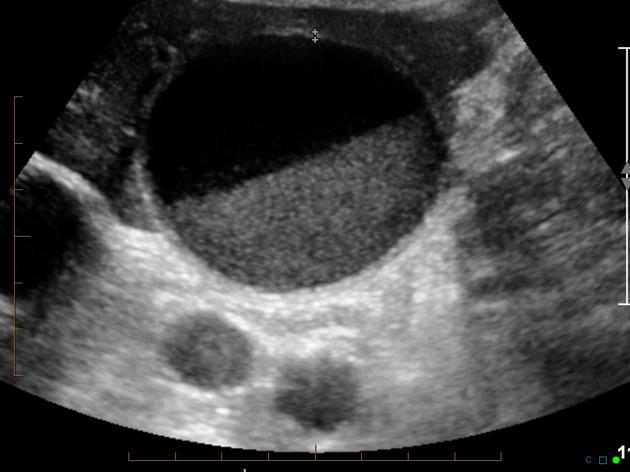What is biliary sludge?
Biliary or gallbladder sludge is a fine sand-like material (silt) in the gallbladder, particles of which are too small (< 1 mm) to be called gallstones. Biliary sludge is precipitated from the bile; it consists of cholesterol crystals, calcium bilirubinate pigment, other calcium salts and mucin [1,7].
Particle size in various gallbladder sediments [2]:
- Biliary sludge: <1 mm
- Small gallstones (microliths): 1-3 mm
- Gallstones: > 3 mm
Causes and Risk Factors
Gallbladder stasis (decreased motility) from any cause and bile duct obstruction seem to be the main risk factors for the development of biliary sludge. The triggers may include [1,4]:
- Pregnancy
- Rapid weight loss, fasting or starvation (very low or no food intake)
- Critical illness that requires total parenteral nutrition (TPN) (by intravenous infusion)
- Surgery of the stomach (gastric surgery)
- Gallstones that obstruct the common bile duct
- Swelling of the head of pancreas (in pancreatic cancer, for example) [4]
- Drugs: ceftriaxone, octreotide
- Bone marrow, liver or other solid organ transplantation
- Improper gallbladder emptying (gallbladder dysmotility) [5]
- Down syndrome [6]
- Bacterial infection [8]
- Food allergies and celiac disease [9]
Gallbladder sludge can either clear on its own when the causes resolve or can develop into gallstones [1].
Symptoms
Gallbladder sludge by itself does not cause any problems, but it can develop into gallstones with time.
Complications include gallbladder pain caused by the blockage of the bile duct (biliary colic), an inflammation of the common bile duct (acute cholangitis) and an inflammation of the pancreas (acute pancreatitis) [1,4]. Symptoms of these complications can include pain in the upper right or middle abdomen, nausea, vomiting or fever.
Another possible complication of gallbladder sludge is biliary dyskinesia (either gallbladder dyskinesia or sphincter of Oddi dysfunction)
Diagnosis
Gallbladder sludge can be detected by a regular abdominal ultrasound [1]. Sludge can be further evaluated by an endoscopic ultrasound or observation of aspirated bile under the microscope [1].
Picture 1. The ultrasound image of gallbladder sludge
(the gray material within the big black hole)
(source: Radiopedia, CC license)
Note that biliary sludge and gallstones can be present in the gallbladder at the same time. On an X-ray image, biliary sludge can mask the gallstones [8].
Treatment
When gallbladder sludge does not cause any symptoms it does not require any treatment. When it causes complications, a surgical gallbladder removal is usually recommended [1].
Sludge can also be removed during a diagnostic-therapeutic procedure called endoscopic retrograde cholangiopancreatography (ERCP) [8].
Gallbladder or Liver Flush
Gallbladder or liver flush is a home remedy intended to promote the passage of sludge or gallstones from the gallbladder. One regime includes eating nothing for the first 12 hours in a day, then taking one tablespoon of olive oil and one tablespoon of lemon juice and repeating this 8 times every 15 minutes [9]. There is INSUFFICIENT EVIDENCE about the effectiveness of such flush [9].
Prevention
There is no known method of prevention of biliary sludge [3].
Diet
Obesity is associated with gallstones, so losing weight (if overweight) may reduce the risk of gallstones and biliary sludge [9]. Note that rapid weight loss may actually increase the risk of gallstones, so you may want to lose weight slowly–up to 2 lbs per week.
There is INSUFFICIENT EVIDENCE about the preventative effect of a diet low in saturated fats, cholesterol, refined sugars or legumes (beans, peas, lentils) or vegetarian diet on the development of biliary sludge or gallstones [9].
There is INSUFFICIENT EVIDENCE about the effectiveness of dietary fiber, caffeine, poly- or monounsaturated fat, vitamin C, soy lecithin or iron supplements in the prevention of biliary sludge or gallstones [9].
- References
- Shaffer EA, 2001, Gallbladder sludge: what is its clinical significance? PubMed
- Steel PAD, 2015, Acute cholecystitis and biliary colic Emedicine
- Ko CW et al, 1999, Biliary sludge Annals of Internal Medicine
- Lee SP et al, 1992, New England Journal of Medicine
- Pazzi P et al, 2003, Biliary sludge: the sluggish gallbladder PubMed
- Boëchat MCB et al, 2007, Cholelithiasis and biliary sludge in Down?s syndrome patients SciELO
- Terada T et al, 1990, Biliary sludge and microcalculi in intrahepatic bile ducts. Morphologic and X-ray microanalytical observations in 18 among 1,179 consecutively autopsied livers PubMed
- Joseph N, 2007, Radiography of the Biliary System CEEssentials
- Gaby AR, 2009, Nutritional approaches to prevention and treatment of gallstones Alternative Medicine Review



OH, another propaganda site by Big Pharm
I came across a diet/tool to eat to remove gallbladder sludge. It consists of shredded beets, lemon juice & oil. Am not sure what oil & amount. I would like to know if this diet is effective, and what amount per hour. Can you find this diet/tool?
I’m not aware of any study that would convince me that the beets, lemon juice, oil or any other food or herb would prevent gallbladder sludge.
I think this is your beet recipe. (Found by Googling.)
2 cups of shredded, raw, preferably organic, ripe beets with the juice of a lemon and 2 tablespoons of extra-virgin, first-pressed olive oil. Eat this mixture between breakfast and lunch and between lunch and dinner daily for 10 days.
What are u refering to when u say beets?what colour r they? Sorry I’m Australian so??Beetroot?…purple?
Yes.